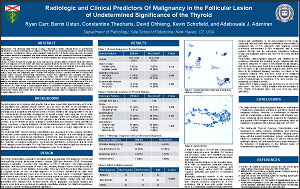Radiologic and Clinical Predictors Of Malignancy in the Follicular Lesion of Undetermined Significance of the Thyroid
Ryan Carr, Berrin Ustun, Constantine Theoharis, David Chhieng, Kevin Schofield, and Adebowale J. Adeniran
Department of Pathology, Yale School of Medicine, New Haven, CT, USA
ABSTRACT
Background:
The Bethesda 2007 Thyroid Cytology Classification defines follicular lesion of undetermined significance (FLUS) as a heterogeneous category of cases that are not convincingly benign nor sufficiently atypical for a diagnosis of malignancy. Various ultrasonographic characteristics of a thyroid nodule have been associated with a higher likelihood of malignancy, and certain clinical features may also increase the likelihood of malignancy in patients. This study is designed to determine the ultrasonographic and clinical predictors of malignancy in the FLUS category.
Design:
A search through the cytology files at our institution from January 2008 to December 2010 was made for cases with diagnosis of FLUS. Cases with follow-up surgical intervention formed the cohort of this study. Surgical pathology and ultrasonographic findings were reviewed. Clinical information was obtained from medical records. The clinical and radiologic findings were correlated with the final surgical pathology diagnosis.
Results:
A total of 140 cases of FLUS with corresponding surgical intervention were identified (112 females and 28 males). There was 75% malignancy rate in nodules with irregular contours, compared with 50% in nodules with regular outlines. Nodules demonstrating calcifications showed 57% malignancy rate, compared with 50% in nodules without calcifications. Malignancy rate in solid nodules was 50%. For cases with a final ultrasound diagnosis of indeterminate to suspicious, 61% were positive on surgical resection. The rates of malignancy in patients with radiation exposure, symptomatic nodules and positive family history of thyroid cancer were 22%, 57% and 33%, respectively. BRAF mutation was demonstrated in 57% of malignant cases and none of benign cases.
Conclusion:
No single clinical or ultrasonographic feature or combination of features is adequately sensitive or specific to identify all malignant nodules. However, a combination of solid nodules, nodules with irregular contours, symptomatic nodules and positive BRAF mutation have high predictive value for malignancy in patients with a cytologic diagnosis of FLUS.
©2012 Yale Department of Pathology. All rights reserved.
Any redistribution or reproduction of part or all of the contents in any form is prohibited. You may not, except with express written permission of the author or the Department of Pathology, distribute or commercially exploit the content, nor may you transmit it or store it in any other website or other form of electronic retrieval system, including use for educational purposes.
